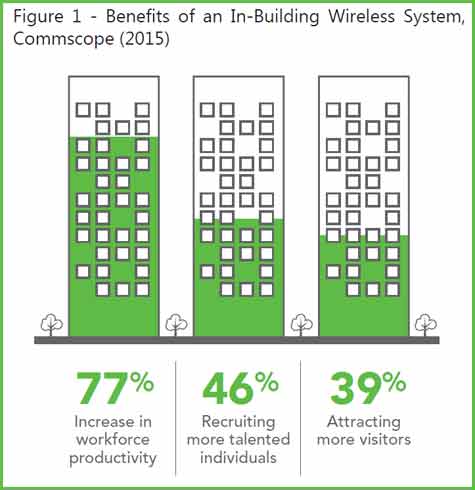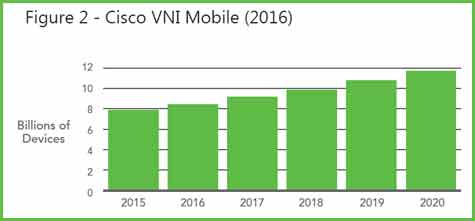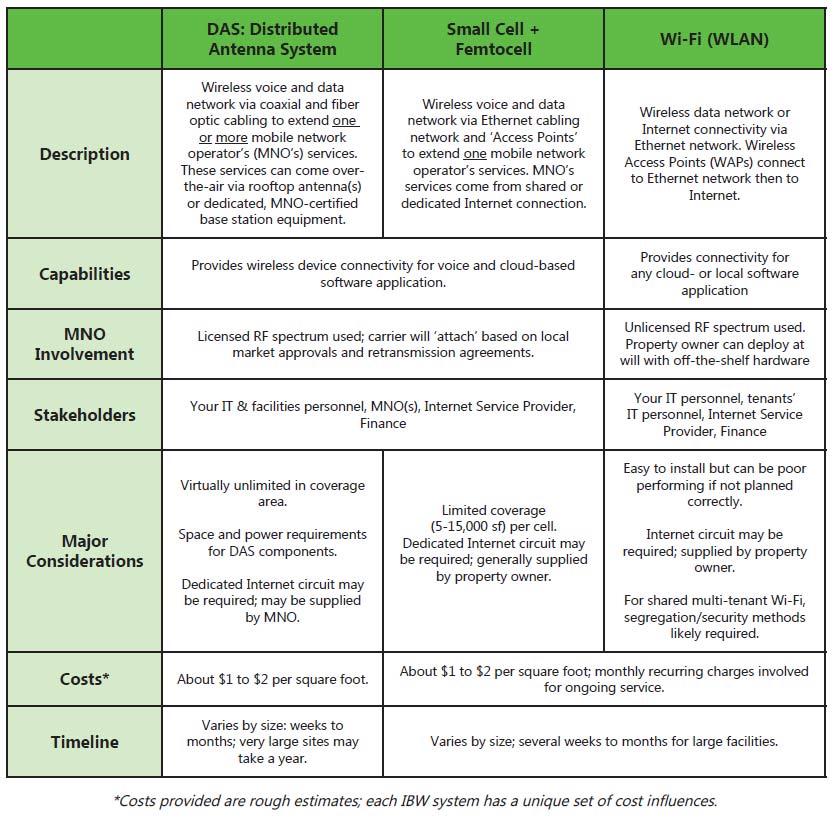
By Vince Varga
Property managers, owners, and builders are missing an opportunity to increase profits through attracting modern, mobility-favoring tenants. The easiest way for a property to miss out on revenue is to lose tenants to turnover, or worse, not to get them in the first place. To get them in the door, your property must be well-maintained in your tenants’ eyes, and your operations staff must be able to work efficiently throughout your property to make this happen. These needs hinge on mobile connectivity, an area in which many properties are lacking. You already provide utilities (water, energy) and amenities (parking, workout facilities), but you may not be aware of In-Building Wireless, a compelling way to attract and retain tenants in our technology-centric era.
 THE OPPORTUNITY
THE OPPORTUNITY
In-Building Wireless (IBW)—which is only present in 2% of commercial real estate space—can be a massive untapped opportunity for property owners and managers to increase the stickiness of their tenants and even their property values (1). For tenants, good mobile connectivity means increased productivity. So much so that 66% of enterprise tenants rated indoor wireless connectivity as essential for employees (1). When these tenants feel more productive, they are more likely to renew their lease.
Benefits for Owners + Tenants
With the direct effects of tenant turnover on property cash flow, increasing tenant satisfaction is an important concern. In order to keep tenants renewing, it is imperative that the property is comfortable and well-maintained with competitive features. In a world where more things, both business- and leisure-related, are web-based, improved mobile connectivity is a strategic way to increase tenant happiness and in turn, property renewals. Research around the issue of managing the high costs of turnover reveals that the best solution is to “never let it get to that point: encouraging renewals is always preferable to turning units over,” and enhancing mobile connectivity is a tactical way to keep tenants renewing (2).
For building management and operations, mobile connectivity is important for staff in the performance of duties around the property. In a survey of property operations staff, half of respondents said that the ability to work from any location at any time has the greatest impact on their productivity (3). Mobile devices are also seen by experts as the largest component in the daily operations of a property (4). Therefore, any gaps in wireless coverage within your property translate into lost efficiency. Seamless connectivity indoors and out is a reality you can create to benefit both your tenants and staff.
THE PROBLEM
Wireless communications are a crucial part of our modern day-to-day lives, but can be frustrating when connectivity is unavailable or unreliable; anyone who has ever dropped or missed a call because of poor cellular coverage knows this. In a survey of business tenants, two-thirds claimed it would be a major challenge to survive without wireless connectivity (5). If a business is lacking coverage and can’t survive in their current workspace, they have two options: find a new space to lease or pressure the owner to fix the problem.
Market studies have exposed a driving need for improving in-building wireless communications, noting that:
- Mobile traffic has increased massively and will continue to grow (6)
- 80% of all data funneled to mobile devices is being consumed indoors (3), and
- more than half of large U.S. offices have noticeably poor indoor cellular reception (7)
Most properties are not exempt from the problem of poor IBW coverage. Three out of four enterprise tenants reported that employees had to move around the building or go outside to find good reception (8). Not only is poor connectivity inconvenient for tenants, but it can be extremely inefficient for building operations staff when they need to work in traditionally poor coverage spaces, like a basement, stairwell, or interior room.
 Who is Responsible?
Who is Responsible?
Unfortunately, it is often unclear who exactly is responsible for improving indoor connectivity. Most building professionals place the responsibility on the mobile network operators to solve the problem (1), but in most cases, it is the property owner’s responsibility to deal with this issue.
For property owners, there are several common roadblocks to implementing an IBW system (1):
- The cost of the network,
- The complexity of the technology, and
- A lack of skilled workers to manage the system
THE SOLUTION
IBW Technology Options
In-building wireless comes in a few different flavors, but the goal remains the same: wirelessly connect tenants, guests, and other building occupants to the network services and software applications that they want and need. Whether it’s in an apartment building, commercial office building, hotel, healthcare facility, school, mall, or public building, everyone now depends on reliable mobile connectivity where they work, live, learn, shop, and play.
IBW for Public Safety
In an emergency event, fire fighters, police, and paramedics require access to a public safety wireless network and this access requirement does not stop at your building’s front door.
Through adoption or amendments of national or international Fire Codes, many jurisdictions require public safety IBW assessments and/or mandate that in-building emergency responder Radio Enhancement Systems (RES) be installed in select new or renovated buildings as a prequalification to a certificate of occupancy.
RES utilize an indoor DAS to extend outdoor public safety radio signaling throughout the building. RES are tied into the building’s fire protection control panel.
For venues of around 100,000 square feet, an RES can be designed, installed and approved within about 30 days.
Commercial real estate professionals need to make sure their architect or general contractor considers the need for RES. The building owner is responsible for the RES cost and can contact a wireless systems integrator to guide them through the process.
With an IBW system, your tenants can be more productive (voice calls & email), more engaged (video collaboration & instant messaging), more efficient (building automation), more entertained (Netflix & Facebook), and safer (911 & public safety).
To create a mobile-friendly property, there are three main technology options available to you: Distributed Antenna System, Small Cells/Femtocells, and Wi-Fi. The benefits and tradeoffs of each are detailed in Table 1.
IBW CONSIDERATIONS
The Mobile Network Operator (MNO)
Mobile Network Operators, also known as wireless carriers (think Verizon, AT&T, Sprint, T-Mobile) have all paid substantial FCC license fees for exclusive access to and control of specific radio spectrum in a given geography. Because of this ownership, carriers require any IBW system to be approved and retransmission of their spectrum authorized prior to connection to their mobile network.
Obtaining this approval involves knowing the right carrier personnel and processes; therefore, when pursuing the implementation of a carrier-involved IBW system, it’s best to engage an experienced supplier with established MNO relationships.
Funding Options
Historically, IBW systems at large-scale public venues, like convention centers and sports stadia, have been funded with MNOs’ capital budgets. At ‘private’ facilities needing improved mobile network connectivity, IBW may be partially funded by the carriers, but only if they have a compelling financial incentive. To determine if there is value in it for them, carriers look at the number of corporate subscribers, the contract term commitment, and the risk of losing those subscribers.
With the increased adoption of BYODA (Bring Your Own Device: the practice in which enterprises allow use of personal mobile network subscriptions and devices [smartphones, tablets, and laptops] for work purposes), MNO-funded IBW is becoming less feasible. Because an enterprise loses its buying leverage with any given carrier, the case for MNOs to invest in the IBW system is largely reduced.
Another funding option is the solicitation of a Third- Party Operator (3PO) to fund, design, and deploy the IBW system. In this arrangement, 3POs typically require a 10-plus-year commitment from the building owner. Although the financing looks attractive, there are risks to the building owner in that any changes or upgrades to the IBW systems are under the control of the 3PO.
Another up-and-coming funding option that several IBW integrators have been offering is an Operating Expense funding model. This method effectively functions like a lease, reducing the need for large capital expenditure while keeping control of the system within the property owner’s hands.
If correctly crafted, property owners can implement a “technology” fee to offset the CapEx and OpEx of IBW systems.
IBW Coverage
It’s important to understand where connectivity is needed within your property, since the entire building may not require coverage from all carriers. A simple assessment survey performed by a reputable integrator can give you an idea of the current baseline coverage your property receives from surrounding outdoor cell sites and what it would take to fill in any holes in coverage.
TABLE 1: IBW Technology Options
 For Wi-Fi services, installation of equipment is relatively simple because the building owner has complete control of the system, meaning no outside approvals are necessary. However, complexity enters the equation when:
For Wi-Fi services, installation of equipment is relatively simple because the building owner has complete control of the system, meaning no outside approvals are necessary. However, complexity enters the equation when:
- Each tenant provides their own Wi-Fi coverage— bringing poor signal quality due to RF interference, or
- The property owner installs one shared Wi-Fi system—bringing complexity in creating secure, segmented, and controlled connections for each tenant.
IBW Care + Feeding
Ongoing IBW network monitoring and management can come from several sources. For very large organizations, a dedicated, internal technical staff should be able to diagnose issues and make changes to the IBW system, although some issues may require outside technical support. For other organizations, external support personnel may make more sense. Monitoring and maintenance service contracts of various scale and scope available on the market.
Sources:
(1) Commscope. (2015). Wireless in Buildings: Overcoming The Barriers to Wireless Connectivity
(2) Isaacs, Linsey & Mearns, Derek. (2013). Keeping Turnover Costs Low. Multifamily Executive
(3) Swabey, Pete. (2016). Mobility, Performance, and Engagement. The Economist
(4) Young, Jim. (2014). Transforming Real Estate Operations with Technology, Automation and Innovation. Realcomm
(5) AT&T. (2013). AT&T Small Business Wireless Rules. AT&T
(6) Lella, Adam & Lipsman, Andrew. (2014). The U.S. Mobile App Report. Comscore
(7) Spivak, Jeffrey. (2014). Raising the (Phone Coverage) Bars in Commercial Buildings. UrbanLand
(8) Commscope. (2015). Wireless at the Office: Are You Meeting Subscriber Demand?
(9) Cisco. (2016). Cisco® Visual Networking Index: Global Mobile Data Traffic Forecast Update, 2015-2020 [White paper]
(10)Barksdale, Matthew. (2014). New Mobile Survey: Where Mobile is Driving the Most Value for Organizations. EngageMobile
 ABOUT THE AUTHOR – Vince Varga is the Manager of Broadband Solutions at Centerline Solutions, a network integrator that balances the technical and business aspects of in-building commercial wireless, public safety, and Wi-Fi projects. A recognized broadband expert, Vince received his Electrical Engineering degree from the University of Nebraska-Lincoln. He can be reached at vvarga@centerlinesolutions.com .
ABOUT THE AUTHOR – Vince Varga is the Manager of Broadband Solutions at Centerline Solutions, a network integrator that balances the technical and business aspects of in-building commercial wireless, public safety, and Wi-Fi projects. A recognized broadband expert, Vince received his Electrical Engineering degree from the University of Nebraska-Lincoln. He can be reached at vvarga@centerlinesolutions.com .















